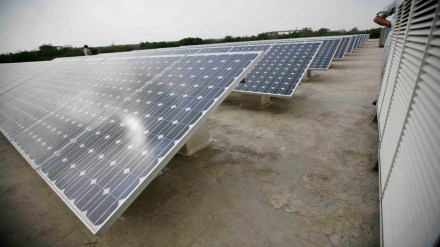Delhi Chief Minister Arvind Kejriwal on Monday announced a new solar power policy for the capital, providing residents with the opportunity to install rooftop solar panels and receive compensation for the electricity they generate. This initiative may lead to some individuals achieving zero power bills, according to the Chief Minister.
Participants in the scheme can also anticipate earning approximately Rs 700-900 per month. The policy links to power production, illustrated by a household using 400 units monthly. If they install a 2-kilowatt solar panel, generating 220 units, these offset their consumption via net metering.
Also Read:Arvind Kejriwal calls Chandigarh mayor election ‘dishonest’, AAP alleges vote tampering
Speaking to The Indian Express, an official said that the net consumption would now be 180 units. “Those who use under 200 units don’t get a power bill in Delhi in any case. Apart from this, you will also be paid for the 220 units that you are generating at Rs 3 per unit,” he said.
Approved by the Cabinet and endorsed by the Lieutenant Governor, the new policy differs significantly from the 2016 version. Notably, there’s no minimum generation requirement for the Generation-Based Incentive (GBI). GBI adjusts against the monthly bill, with surplus credited monthly, departing from semi-annual transfers.
Participants in the scheme will also benefit from a capital subsidy of Rs 2,000 per kilowatt of installation, up to a maximum of Rs 10,000 per consumer. This subsidy is in addition to the support the Central government provides, which ranges from Rs 16,000-18,000 per kilowatt.
Also Read:Ahead of Budget Session, Parliamentary Affairs Minister says suspension of all 150 MPs to be revoked
How is the new policy better than the old one?
The government’s new solar policy, introduced to overcome challenges posed by its 2016 predecessor, aims to address various issues. The previous policy saw limited success, with only approximately 250 megawatts installed by consumers, attributed to factors such as low user interest, inadequate power generation, and quality concerns.
Officials identified key issues in the previous policy, including cost-related concerns, meeting incentive targets, installation quality, and maintenance challenges. The upfront subsidy and high benchmark for the generation-based incentive were significant drawbacks.
In contrast, the new policy incentivises users to continue electricity production from solar panels post-installation. Unlike the previous benchmark of 1,100 units per annum, which posed maintenance challenges, the revised policy offers incentives for even minimal electricity generation. This encourages users to maintain panel cleanliness and functionality.
Quality concerns with solar panels in the previous policy are addressed by involving only verified and technically qualified vendors, with a potential minimum generation guarantee.
The new policy also tackles financial barriers by proposing an EMI option for installation. This allows middle-class individuals to spread the cost over time, aligning with the common purchasing approach for household items.
An official explained that the current electricity subsidy provides a benefit of only Rs 800 a month, mainly for consumers using around 200 units. The additional subsidy and generation-based incentive are expected to attract more users to adopt solar power, despite the initial cost of quality panels ranging from Rs 40,000 to Rs 1 lakh and above.
To get solar panels installed in Delhi under the new policy:
- Check the authorised vendor list on the government website.
- Download the list, choose a vendor, and call them for installation.
- Once installed, a net meter will be installed by Discoms.
- Electricity bills will reflect adjusted units and excess power generates earnings.
- No additional documents are required.
Subsidy:
- Rs. 2,000 per kW, up to Rs. 10,000 per consumer.
Earnings:
- Rs. 3 per unit for small panels (up to 3 kW).
- Rs. 2 per unit for larger panels (3 to 10 kW).
